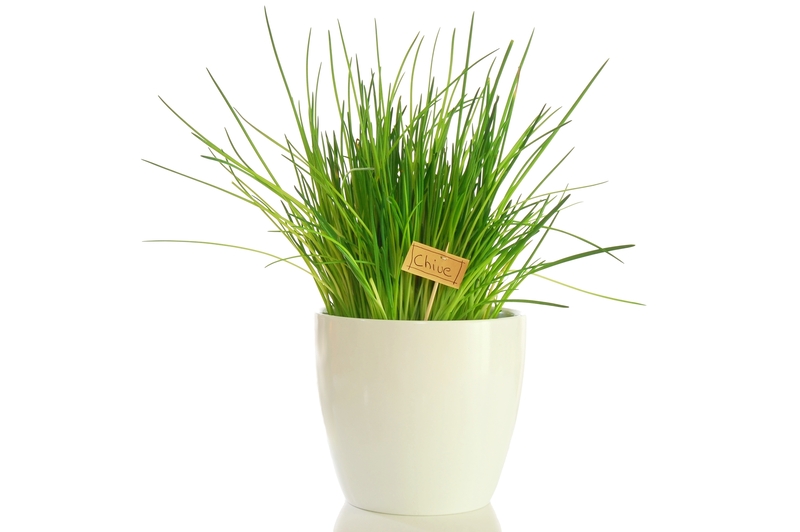Transform Your Walls with Vertical Gardening
Posted on 30/08/2025
Transform Your Walls with Vertical Gardening: A Modern Guide
Are you looking to breathe new life into your living or working space? Vertical gardening can be the perfect transformative solution. Whether you have a blank wall indoors or a small outdoor area, vertical gardening offers endless possibilities for adding greenery and drama, even to the most compact spaces. In this in-depth guide, discover how to transform your walls with vertical gardening, key benefits, practical tips, creative ideas, and the best plants to ensure success.

What Is Vertical Gardening?
Vertical gardening is the innovative practice of growing plants upwards using vertically suspended panels, trellises, or modular systems. This method allows you to make the most of limited floor space by turning empty walls into stunning, living works of art. Also known as living walls or green walls, vertical gardens can be as simple as trailing plants cascading from shelves, or as complex as large-scale hydroponic installations.
Why Choose Vertical Gardening?
- Space Efficiency: Make gardening possible even in tiny apartments, balconies, or patios.
- Improved Air Quality: Plants filter toxins and produce oxygen, making your indoor air fresher.
- Aesthetic Appeal: Vertical gardens act as striking visual features and focal points.
- Noise Reduction: Dense greenery helps absorb sound, creating a more peaceful environment.
- Natural Insulation: Living walls moderate temperatures and can increase energy efficiency.
- Biodiversity: Attract birds, bees, and butterflies, enhancing urban ecosystems.
Types of Vertical Gardens for Stunning Walls
There are various methods to reclaim your walls with vertical gardening. Each offers unique aesthetics, functionality, and maintenance requirements. Let's explore the most popular types:
1. Living Wall Panels and Modular Systems
These are pre-assembled panels equipped with built-in containers and irrigation systems, making them ideal for both residential and commercial spaces. Modular systems are customizable and allow you to expand or reconfigure your vertical garden as needed.
2. Hanging Planters and Pocket Planters
Fabric or felt planters that attach directly to your walls are great for herbs and small flowers. Hanging pots, baskets, or upcycled containers hung on sturdy hooks offer a versatile, straightforward method of achieving vertical greenery.
3. Trellises and Climbing Plant Supports
Use trellises for climbing plants such as ivy, philodendron, and jasmine. Trellises take up little space, can be attached to almost any wall, and are particularly popular for outdoor spaces.
4. Recycled and Upcycled Vertical Gardens
Transform everyday items--wooden pallets, plastic bottles, shoe organizers--into unique vertical growing systems. Not only is this eco-friendly, but it also enables personal creativity and statement-making decor.
5. Shelving and Ledge Systems
Install shelves close together on a wall and fill them with an array of small planters. This method is especially suited for indoor vertical gardens and can hold small succulents, ferns, or cascading vines.
How to Plan and Design Your Vertical Garden
The key to a successful green wall lies in thoughtful planning. Consider the following steps as you get started.
1. Choose the Right Location
- Assess Sunlight: Observe how much sunlight your chosen wall receives throughout the day. Sun-loving plants need bright spots, while shade-tolerance opens up more options, especially indoors.
- Accessibility: Pick a spot where you can water, prune, and maintain your vertical garden easily.
2. Select the Perfect Plants
Not all plants thrive in a vertical garden environment. Consider the following popular choices:
- Ferns: Excellent for humid, shaded environments.
- Succulents: Thrive with little water and lots of sunlight.
- Trailing Vines: Pothos, philodendron, and ivy elegantly cascade downwards.
- Herbs: Mint, basil, thyme, and oregano are ideally suited for kitchen green walls.
- Ornamental Grasses: Add unique texture and movement.
- Flowering Plants: Begonias, petunias, and impatiens brighten up any space.
Pro Tip: Mix different species to create a dynamic, textured look and to ensure year-round interest.
3. Design for Irrigation and Drainage
Irrigation is crucial since vertical gardens tend to dry out faster than traditional plots. Opt for self-watering systems or drip irrigation for large walls. Smaller installations may require hand-watering, so ensure you have easy access to water sources.
4. Select the Right Structure
Pick the vertical gardening system that fits your space, budget, and aesthetic ambitions. Pre-fabricated living wall kits are user-friendly, while DIY solutions allow for unlimited creativity.
Step-by-Step Guide: Installing a Vertical Garden on Your Wall
Ready to transform your wall into a lush oasis? Here's how to get started:
- Step 1: Plan Your Layout
- Sketch your design for better visualization.
- Decide on a symmetrical, geometric, or organic pattern as suits your decor.
- Step 2: Prepare the Wall
- Ensure the wall is strong enough to support the garden's weight.
- Install waterproof membrane if indoors to prevent moisture damage.
- Step 3: Install Support Structure
- Fix trellises, panels, or frameworks as required by your chosen system.
- Step 4: Arrange and Plant
- Fill planters or pockets with a lightweight soil mix.
- Position plants based on height and light needs.
- Step 5: Set Up Irrigation
- Connect drip lines or arrange for regular manual watering.
- Step 6: Enjoy and Maintain
- Check weekly for watering, feeding, and any pest issues.
Vertical Gardening Design Ideas to Inspire
1. Herb Kitchen Wall
- Install pocket planters near your kitchen for easy access to fresh herbs.
- Use labeled pots for an organized, rustic look.
2. Indoor Living Art
- Arrange succulents and tropicals in framed panels for a living picture effect.
- Use different shades of green to add depth and contrast.
3. Balcony or Patio Screening
- Grow flowering vines or tall grasses to create privacy screens on your balcony.
- Mix flowering plants with foliage for continual color and interest.
4. Urban Green Facade
- Install trellises on exterior home walls and plant fast-growing climbers for shade and curb appeal.
- Try jasmine for scent or clematis for vibrant blooms.
5. Upcycled Pallet Garden
- Repurpose a wooden pallet into a vertical garden by adding landscaping fabric and soil.
- Fill spaces between planks with a mix of herbs, lettuces, or trailing flowers.
Key Tips for Successful Vertical Gardening
- Start Small: Begin with a modest-sized installation to perfect your techniques before scaling up.
- Choose Hardy Plants: Select plants that can cope with variable lighting and quicker drying in vertical setups.
- Regular Maintenance: Schedule weekly checks for watering, deadheading, and pest management.
- Use Quality Potting Mix: Lightweight, nutrient-rich blends reduce the burden on your wall and keep plants thriving.
- Fertilize Carefully: Slow-release fertilizers work best for vertical gardens to avoid overfeeding or runoff.
- Mind the Seasons: Rotate plants seasonally for all-year beauty and vigor.
Best Plants for Vertical Walls
When it comes to vertical gardening, plant selection is critical. Here are some of the best choices to transform your walls with vertical gardens:
- Indoor Favorites:
- Pothos
- Spider Plants
- Boston Fern
- Peperomia
- Heartleaf Philodendron
- Outdoor Show-Stoppers:
- Clematis
- Jasmine
- Sweet Pea
- Climbing Hydrangea
- Honeysuckle
- Edibles:
- Strawberries (great for hanging pocket gardens)
- Mixed Salad Greens
- Chives
- Lettuce
- Chili Peppers
Overcoming Challenges in Vertical Gardening
While vertical gardening brings countless benefits, it also presents unique challenges:
- Watering Difficulty: Vertical gardens dry out faster. Consider automated watering systems or frequent manual checks.
- Pests and Diseases: Crowded conditions can encourage mold or insects. Ensure regular ventilation, pruning, and monitoring.
- Structural Load: Some living walls can be heavy. Confirm your wall's strength or use lightweight alternatives.
- Sunlight Distribution: Parts of your wall may receive less light. Group sun and shade plants appropriately.
Sustainable and Eco-Friendly Aspects
One of the biggest advantages of vertical gardening is its environmental impact:
- Reduces Urban Heat Island Effect: Vegetated walls help cool buildings and reduce energy needs.
- Improves Air Quality: Plants capture pollutants and dust, contributing to better health.
- Encourages Recycling: Use repurposed materials for planters to cut down on waste.

Frequently Asked Questions about Vertical Gardening
Is vertical gardening suitable for beginners?
Absolutely! Starting small with easy-to-grow plants makes vertical gardening accessible for all skill levels.
Can I grow vegetables in a vertical garden?
Yes, many vegetables such as lettuce, chard, herbs, and even tomatoes grow well vertically. Just ensure adequate soil, sunlight, and support.
How do I keep my vertical garden healthy?
Check regularly for water needs, prune dead foliage, use quality soil, and fertilize appropriately for lush results.
Conclusion: Transform Your Walls with Living Beauty
Vertical gardening is more than just a home improvement trend--it's a creative, practical solution for modern living. Whether inside or outdoors, you can transform your walls with vertical gardening to enjoy cleaner air, vibrant aesthetics, and a closer connection to nature. From simple DIY projects to bold living wall installations, your options are endless. Why settle for blank walls when you can create a stunning, living masterpiece right at home?
Get started today and elevate your environment--one plant at a time!

